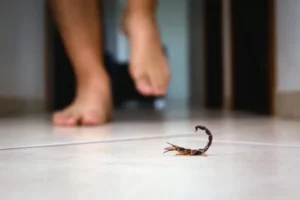Home / Blog / What is a Cicada? Their Appearance, Behavior, and More
What is a Cicada? Their Appearance, Behavior, and More

Scientifically reviewed by Daniel Baldwin, BCE, CCFS, CP-FS
-Published on May 16, 2023
-Updated on July 13, 2023
If you’re outdoors in the summer and early fall, you may hear a distinct humming sound coming from areas where there are hardwood trees. That sound is chirp from a cicada, an unusual insect that’s largely misunderstood. Read on to get the facts about cicadas and their environment.
What is a cicada?
A cicada is a type of insect that is a member of the Cicadoidea family. You may sometimes see them referred to as jar flies. However, they’re not from the same order as conventional black flies.
Part of the reason for the nickname is that cicadas have sheer wings that fold over their backs, similar to the wings found on common flies. Cicadas actually possess four wings: two shorter front wings and two longer back wings.
Normally, they are green or brown and have black markings on their backs. Other notable characteristics include eyes on the front sides of their heads and very short antennae.

How big are cicadas?
Most full-grown cicadas are 1 to 1.5 inches long. Immature nymphs are shorter and have stouter bodies that make them look similar to beetles.
Why do cicadas molt?
Cicadas must molt to grow. They have hard outer coverings called exoskeletons that can’t stretch as the insects become larger. As a result, they molt or shed their outer skin, giving them more room to lengthen and widen.
Where do cicadas live?
There are species of cicadas in all parts of the U.S. They prefer to lay their eggs around hardwood trees like cherry, hawthorn, maple, oak, and redbud. Cicadas are less likely to choose evergreen trees as sites for egg-laying.
You don’t need to be in a heavily forested area to have cicadas. The insects can live in public parks and along tree-lined streets in cities and suburban areas.
How long do cicadas live?
How long cicadas live depends on their type: annual cicadas versus periodical cicadas.
Annual or dog-day cicadas appear every year between July and August and remain until September. These cicadas typically live for around two to five years. Periodical cicadas have longer life spans, emerging every 13 to 17 years. These cicadas usually survive through one periodic cycle and then die.
Both types of cicadas spend most of their lives in the nymph stage. Once they reach maturity, they usually live for only two to four weeks. That’s still enough time for females to lay anywhere from 400 to 600 eggs in trees.
What do cicadas eat?
Cicada larvae and mature cicadas eat slightly different things. Cicada larvae burrow underground and live off fluids they draw out of the roots of trees and woody shrubs with specialized mouthparts. Adult cicadas suck fluids from the trunks and branches of trees and woody shrubs once they reach above the ground.
Why do cicadas make noise?
Cicadas are well known for their distinctive noise, but only the males produce it. The sound helps to draw female cicadas out for mating.
What do cicadas do for the environment?
Although their noise can be a nuisance, cicadas benefit the environment. By burrowing underground, they increase airflow through the soil to encourage the growth of plants. Animals that dig can feed on cicada larvae, and the adults provide food for birds and other wildlife once they emerge. When cicadas die, they return nutrients to the soil.
How often do cicadas come out?
As previously mentioned, there are two kinds of cicadas. Annual ones come out yearly, while the periodical species emerge every 13 to 17 years.
What do cicadas do underground?
If you live in an area home to the periodical species, you may wonder where cicadas come from all of a sudden. Cicada larvae fall out of their nests in trees a few days after hatching. They then tunnel underground to hide while they mature. During this time, they spend their days feeding off roots and growing. They’ll then come above ground to molt into adults and mate.
Are cicadas dangerous?
Cicadas can’t sting or bite humans or pets, and larvae are unlikely to damage trees or plants when they feed. However, females can harm trees when they build their nests.
Related Articles
Visit our blog to learn more.
→






